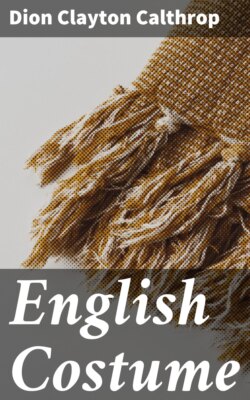Читать книгу English Costume - Dion Clayton Calthrop - Страница 11
На сайте Литреса книга снята с продажи.
THE MEN
ОглавлениеTable of Contents
About this time there came to England a Norman, who settled near by the Abbey of Battle—Baldwin the Tailor by name, whom one might call the father of English tailoring.
Baldwin the Tailor sat contentedly cross-legged on his bench and plied his needle and thread, and snipped, and cut, and sewed, watching the birds pick worms and insects from the turf of the battleground.
A MAN OF THE TIME OF WILLIAM II. (1087-1100)
Shows the wide drawers with an embroidered hem. Under them can be seen the long woollen drawers bound with leather thongs.
England is getting a little more settled.
The reign opens picturesquely enough with William Rufus hastening to England with his father’s ring, and ends with the tragedy of the New Forest and a blood-stained tunic.
Clothes begin to play an important part. Rich fur-lined cloaks and gowns trail on the ground, and sweep the daisies so lately pressed by mailed feet and sopped with blood where the Saxons fell.
The Cloak pushed through a Ring.
Times have changed since Baldwin was at the coronation at Westminster on Christmas Day twenty years ago. Flemish weavers and farmers arrive from overseas, and are established by William II. in the North to teach the people pacific arts, causing in time a stream of Flemish merchandise to flow into the country, chiefly of rich fabrics and fine cloths.
The men adopt longer tunics, made after the same pattern as before—split up either side and loose in the sleeve—but in many cases the skirts reach to the ground in heavy folds, and the sleeves hang over the hands by quite a yard.
The necks of these tunics are ornamented as before, with coloured bands or stiff embroidery.
The cuffs have the embroidery both inside and out, so that when the long sleeve is turned back over the hand the embroidery will show.
The fashion in cloaks is still the same—of a semicircular pattern.
The shoes are the same as in the previous reign—that is, of the shape of the foot, except in rare cases of dandyism, when the shoes were made with long, narrow toes, and these, being stuffed with moss or wool, were so stiffened and curled up at the ends that they presented what was supposed to be a delightfully extravagant appearance.
They wore a sort of ankle garter of soft leather or cloth, which came over the top of the boot and just above the ankle.
The hair, beard, and moustaches were worn long and carefully combed—in fact, the length of the beard caused the priests to rail at them under such terms as ‘filthy goats.’ But they had hardly the right to censorship, since they themselves had to be severely reprimanded by their Bishops for their extravagance in dress.
Many gentlemen, and especially the Welsh, wore long loose trousers as far as the ankle, leaving these garments free from any cross gartering. These were secured about the waist by a girdle of stuff or leather.
The ultra-fashionable dress was an elongation of every part of the simple dress of the previous reign. Given these few details, it is easy for anyone who wishes to go further to do so, in which case he must keep to the main outline very carefully; but as to the actual length of sleeve or shoe, or the very measurements of a cloak, they varied with the individual folly of the owner. So a man might have long sleeves and a short tunic, or a tunic which trailed upon the ground, the sleeves of which reached only to the elbow.
I have noticed that it is the general custom of writers upon the dress of this early time to dwell lovingly upon the colours of the various parts of the dress as they were painted in the illuminated manuscripts. This is a foolish waste of time, insomuch as the colours were made the means of displays of pure design on the part of the very early illuminators; and if one were to go upon such evidence as this, by the exactness of such drawings alone, then every Norman had a face the colour of which nearly resembled wet biscuit, and hair picked out in brown lines round each wave and curl.
These woollen clothes—cap, tunic, semicircular cloak, and leg coverings—have all been actually found in the tomb of a Briton of the Bronze Age. So little did the clothes alter in shape, that the early Briton and the late Norman were dressed nearly exactly alike.
When the tomb of William II. was opened in 1868, it was found, as had been suspected, that the grave had been opened and looted of what valuables it might have contained; but there were found among the dust which filled the bottom of the tomb fragments of red cloth, of gold cloth, a turquoise, a serpent’s head in ivory, and a wooden spear shaft, perhaps the very spear that William carried on that fatal day in the New Forest.
Also with the dust and bones of the dead King some nutshells were discovered, and examination showed that mice had been able to get into the tomb. So, if you please, you may hit upon a pretty moral.
